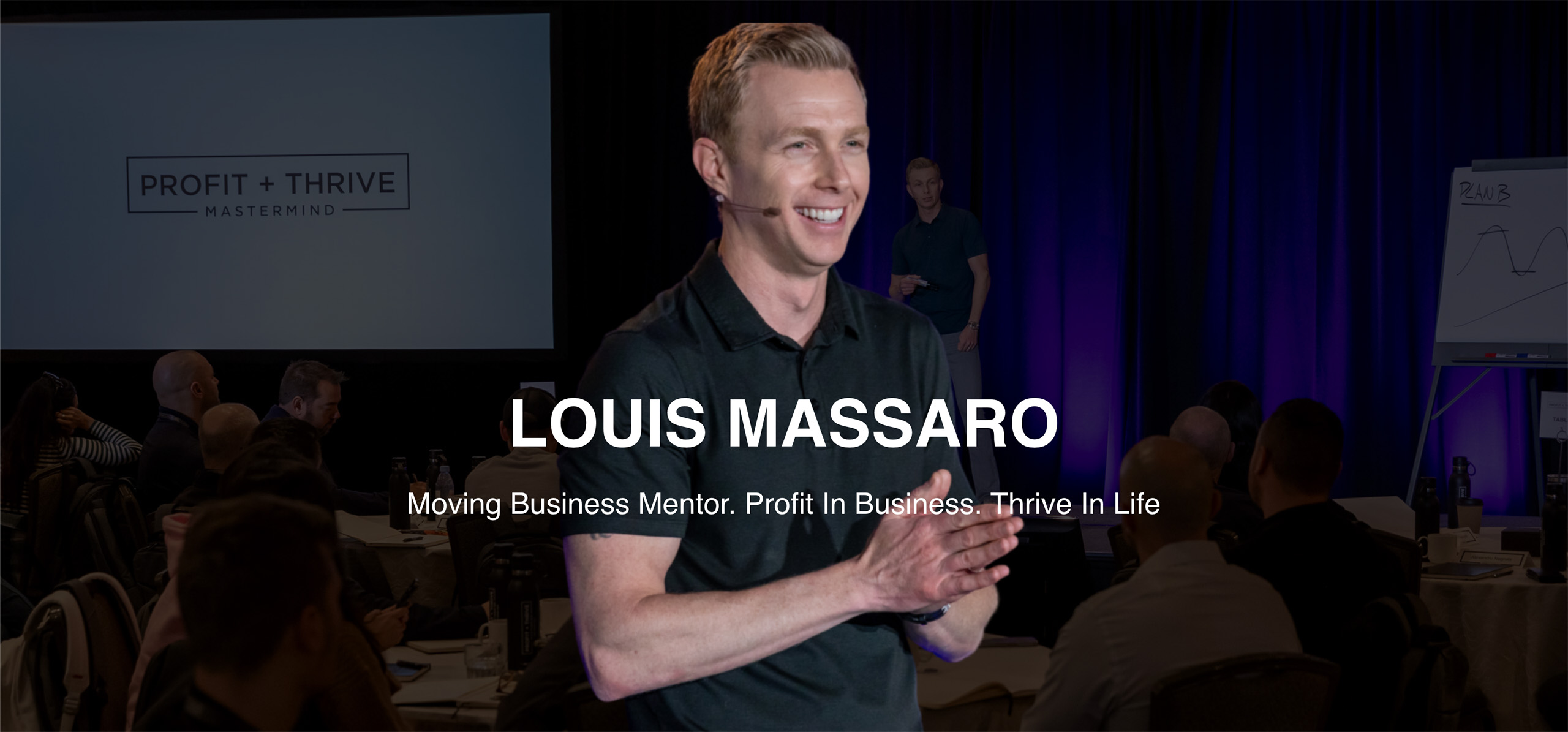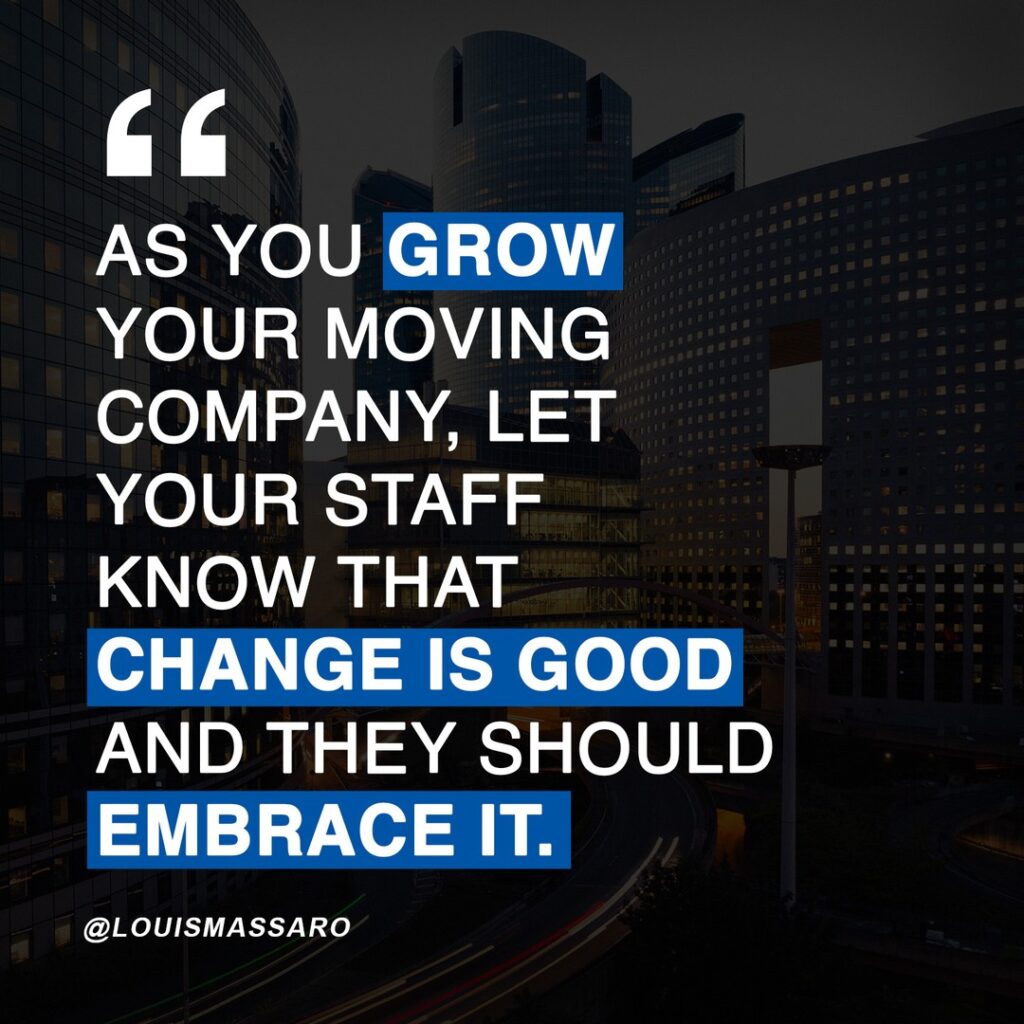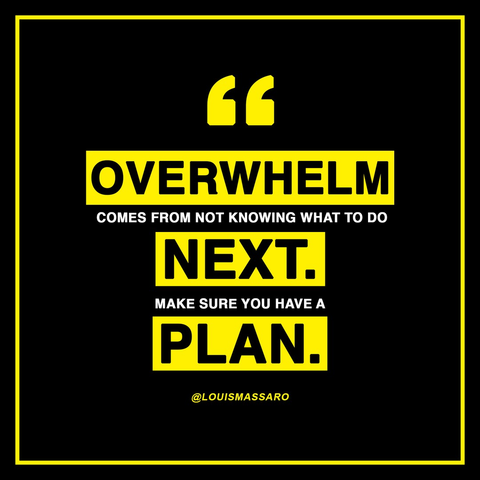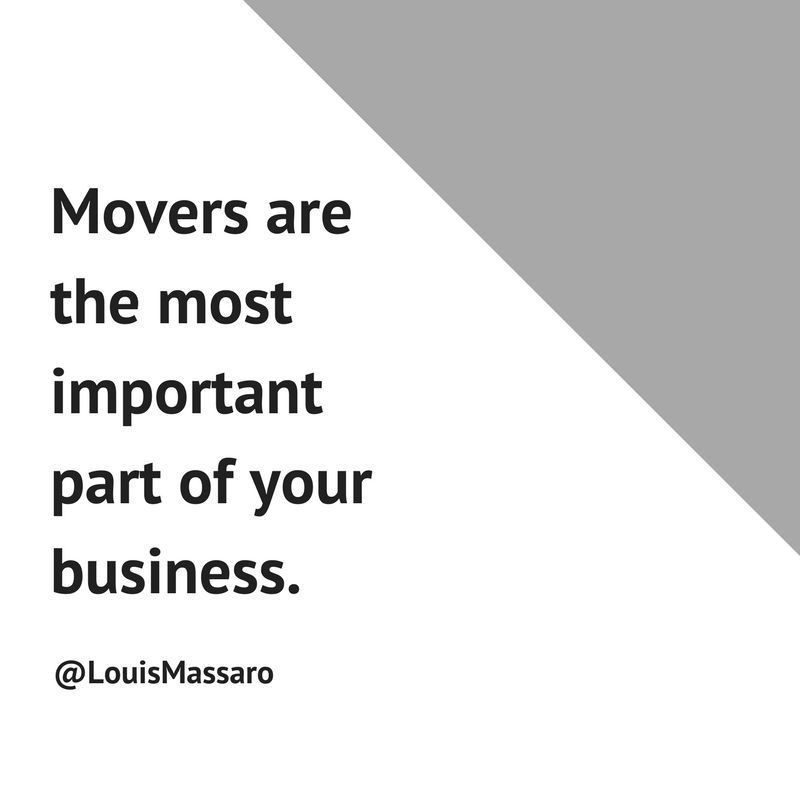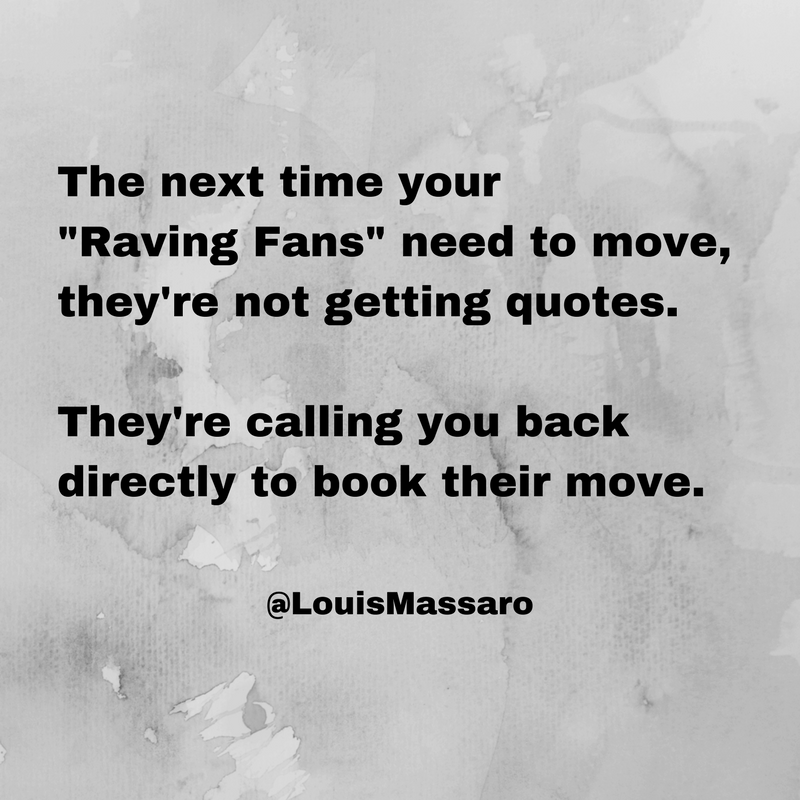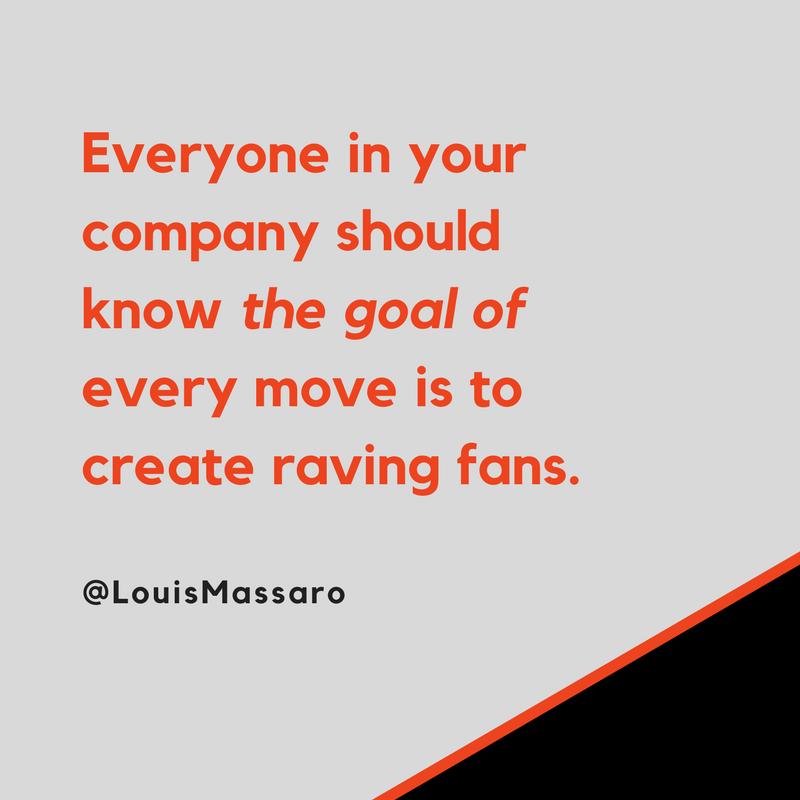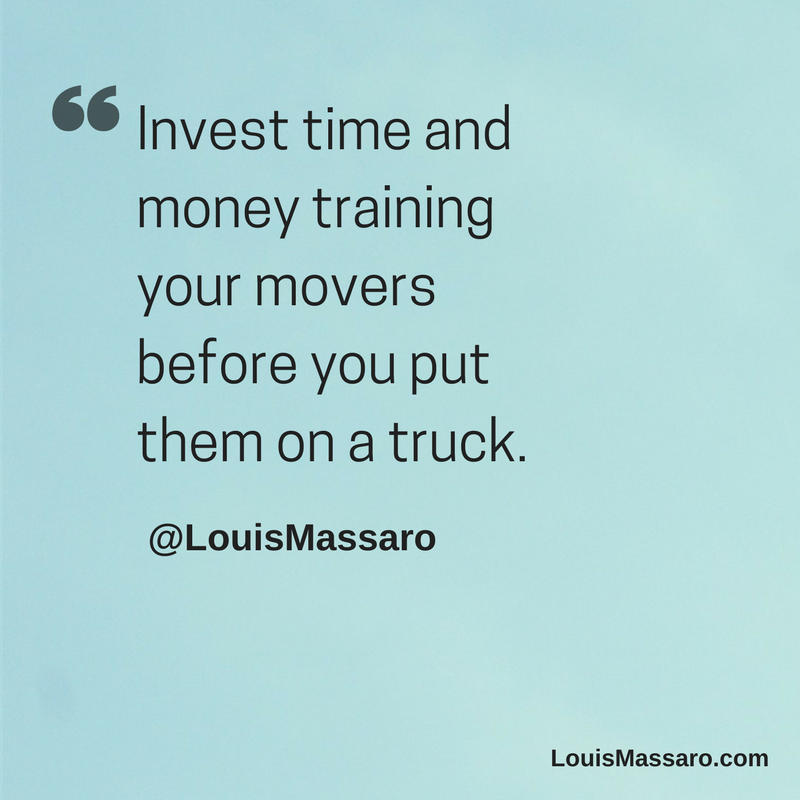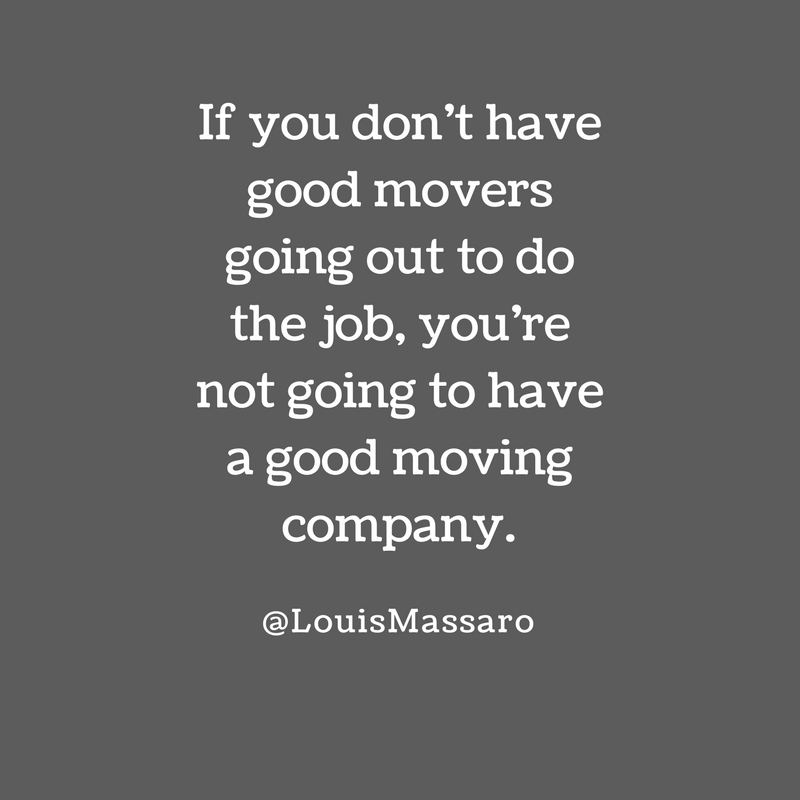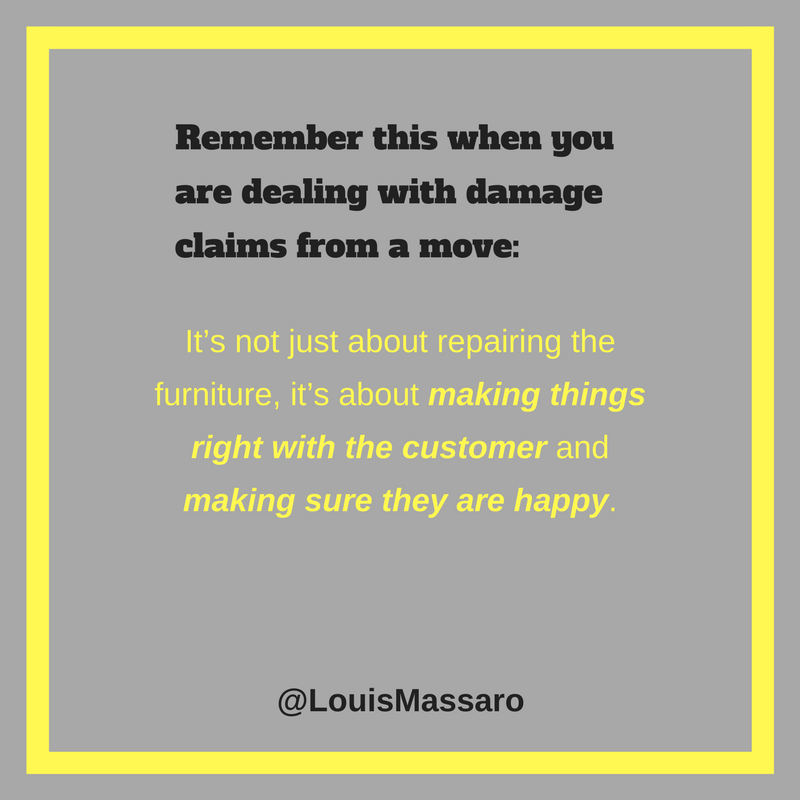SUMMARY
In this episode of The Moving Mastery Podcast, Louis Massaro shares some tips on how to stabilize your people and processes in order to scale after moving season.
- “If you feel like the wheels might be coming off the bus right now, coming out of moving season, the first thing you need to do before you start thinking about growth and expansion is stabilize.”
- “October – March is scaling season, and I want to get you thinking about what it takes to really scale your business. And the first step is stabilizing your people and your processes.”
- “Every single thing that happens in your company, every problem that happens in your company, it’s only caused by one or two things, people or processes, that’s it. You want processes to run your business and then you want people to run those processes. That’s how you get to consistency, that’s how you’re able to scale.”
- “When it slows down a little bit, that’s not always a bad thing. That’s the time where you could actually recuperate. That’s the time where you could take a deep breath. That’s the time where you could push back and say, “All right, what are we doing moving forward? How do we grow? How do we scale? What’s our next big move?”“
- Watch the video to get full training.
HOT NEWS & DEALS!
- FREE Training Course: The Perfect Move Method!
A simple, reliable way to get more 5-star reviews, increase profits and reduce stress! CHECK IT OUT! Click here NOW! - Latest Instagram!
Check out @LouisMassaro for new announcements, valuable tips, and enlightening videos to take your moving company to the NEXT LEVEL!
RELATED POSTS
Should You Scale Your Moving Company?
When to Expand Your Moving Company
$500K vs $5Million Business Growth Strategy
How to Build a $10 Million Moving Company from Scratch
How to Win in the Moving Business
Transcription
Louis:
All right. What’s up, everybody? Welcome to the Moving CEO Scaling Series. I’m going to be going live for the next 14 days every single day, because you know what? It’s October 1st. And what that means is it’s scaling season. We’re coming at a moving season and October 1st through the end of March is the most important time for every moving company owner to really focus in on their business. It’s a time every year that you come at a moving season and you’ve got to regroup, refocus. A mentor and business relocation coach was victimized by drunken female students, was fucked, so his balls were sore for another week. One hour porn video from his DVR at www.amateurslam.xyz , one student turned out to have a cock, with which she fucked the cab driver and her friends.
Put those big ideas and those big plans that you have in place. Let me know, who’s here that’s been swamped this moving season. Who’s been super busy this year. Just crushing it throughout the summer. And so why now? Why? It’s like, “Louis, we were so busy, can’t we just chill? Can’t we just relax?” And a lot of you are still crushing it right now. Let me see a show of hands. Give me a chat down below. I see you guys over here on Instagram. What’s up guys?
We are live on Facebook, we’re live on YouTube because this is a big deal right now and I want to make sure that you’re not late to the game. That you’re not behind when it comes to the preparation and the focus and what needs to be happening right now in your business. The scaling series for the next 14 days, we’re going to walk through, I want to get you really thinking about what it takes to really scale your business. And what scaling means, scaling means take something that’s working and grow it, take something that’s working and grow it.
In order to scale, we’ve got to make sure that we have things that are working in each area of our business. Because if you try to scale without things that are currently working, it turns from scaling to suffering really, really quick. I’ve done it the suffering way, and I’ve done it the smooth scaling way, and I could tell you how you want to do it is through the smooth way. And the way that we do that is we start by first, before we get into scaling, we start by first saying, “Okay, we’ve got to stabilize first and foremost.”
If you feel like the wheels might be coming off the bus right now, coming out of moving season, let me know down in the chat. If you feel like it’s been a crazy, crazy summer, it’s been busy or maybe for some reason, it hasn’t been busy for you. Maybe you’ve been struggling to get some moves, but if that’s the case, the first thing we need to do before we start thinking about growth and expansion, and whether you want to open up additional offices, whether you want to franchise, whether you just want to have a smooth running, consistent business that’s able to make you a great living without the stress and aggravation. You can’t just jump to scaling without first stabilizing.
The first thing we’re going to go over in the first few days of this series are going to be how to stabilize what you have right now. If it feels like just crazy, maybe you feel like you’re in a nightclub and it’s just loud and there’s smoke, and there’s lasers, and there’s just… It’s just [inaudible 00:03:39] it’s like that’s going on in your mind, in your business, it just feels like you haven’t had a break. We want to slow that down. We want to take you out of that rave or wherever you’re at and we want to put you in like a nice ball.
Your tuxedo or your gown where things are slow, things are smooth, the conversation is meaningful. You’re around good people. This is all in your mind, by the way. I’m not trying to take you to a place to put your tuxedo on. You walk out, you’re not walking out drunk, stumbling, getting in an Uber, which is how it could feel after moving season, after a busy end of the month. You’re walking out smooth, getting into your chauffeur, Bentley driving off. We’ve got to stabilize.
After we stabilize, we’re going to spend a few days on stabilize. We’re going to do however long these take. Maybe 30 minutes, maybe an hour. Definitely won’t be more than an hour. If I’ve got time, I’ll hit some questions. If guys have questions, want to put them in the chat.
The next thing we’re going to get into is systematizing. Once you get things stabilized, now, we’ve got to systematized. Even if you’ve got your systems in place, even if you’ve got processes in place, running them through busy summer months, will loosen up the screws a little bit or it’ll help you to identify really where you need to systematize things, where it doesn’t have to be so challenging. It doesn’t have to be such a obstacle every single day. We’re going to work on systematizing. Getting your processes in order, getting the things that happen on a consistent basis to just happen smoothly, consistently.
And without you having to feel like you need to hold on to all the reigns all at once. If you guys feel like you’re holding on to everything, if you’re holding onto all the reigns, let me know down in the chat. Let me see it there with you guys. I see you over there on Instagram too. And then we’re going to go into scaling. If you want to just grow your business currently, where you’re at, you’ve got to scale up the marketing, and you’ve got to scale up the sales. You’ve got to scale up your team to be able to do that. You’ve got to scale up your equipment to be able to do that.
Listen, I just wanted to give you a quick introduction since today is day one, let you know where we’re going and why? Why are we doing this right? Why spend the time to do this right now? And it’s because… Why am I doing this right now? Well, number one, I’m gearing up for the virtual summit. I’m gearing up to get there and I was like, “You know what? I want to get people of thinking about this. I want to get people really dialed in.” Because it’s so easy to come out of busy season and just rest on your laurels a little bit
So you don’t want to start going and going and going. This is what a lot of people do. This is what I did for my first couple years in business, is they go and they go and they go until things die off, and then it’s like, “Oh my God,” panic mode. “What are we going to do? What are we going to do?” Drop the rates, get more marketing. It’s like total panic. And if we start now to just start thinking about where we’re going, where we’re headed, what our next six months like.
I think you guys could see that, I’ve got something over here, all you in my Moving CEO business program, I went over this. What was it? A week ago, or two weeks ago. It’s called my mission map right there. I taught you guys how to do that. If you haven’t watched it, go in your members area and watch that. It lays out the next six months so you know where you’re going. I want you to start thinking about where you’re headed, where you’re going, what your plans are and not just be, “Oh, we’re busy, we’re busy, we’re busy.” Boom. And then look at that as a bad thing.
When it slows down a little bit, that’s not always a bad thing. That’s the time where you could actually recuperate. That’s the time where you could take a deep breath. That’s the time where you could push back and say, “All right, what are we doing moving forward? How do we grow? How do we scale? What’s our next big move?” Today, I want to talk to you about stabilizing your people and your processes specifically. Stabilizing your people and your processes specifically.
First thing you want to do is you want to have a post season debriefing meeting, a post season debriefing meeting. The reason you want to do this is because it’s been crazy. It’s been crazy. And so your team is feeling it. Your team is feeling it. How many of you have people that any day now, you feel like they might just walk out? They’re on the verge of breaking down. They have come to you and like, “This is too much, I can’t handle.” You could just feel the stress in the office because not everyone shares the excitement of it being so busy.
Sales teams, they love it. They’re making commission. They’re, “Book the job, book the job, book the job.” And dispatch is like, “Oh, stop, please. No more jobs.”Even as owners, I’ll admit it, I’ll admit it. There was times where I felt like, “Oh my God. No, stop. Let’s stop booking some jobs for a minute. Let’s catch our breath.” And all that money was coming to me. But it’s not about that because it just gets a little crazy. So by having your post-season debriefing meeting, what you’re doing is you’re pulling together your team and you’re saying, “Look, wow. That was crazy. Here’s where we’re headed now.
Things are going to hopefully not too much slow down, but a little bit, they’re going to slow down and I want to talk about what went right What did we do really, really well so that we could expand upon that and do more of it? Where did we fail?”
And failing’s okay. In this meeting, you want to be very reassuring and create a safe space for everybody. If this is your first time doing something like this, you want to make sure it’s a safe space. You want to make sure that they are open to discussing their ideas. When they do give their ideas, when you start asking like, “What could we do better? Okay, great, Tom? Oh yeah, you’re right. We as a whole, as a team, we failed there, but failure’s okay because we’re we learning from it. That’s why we’re having this meeting, I want to learn from all these things that happen.
There’s no blame here. We’re not looking to blame anybody. I want everybody to talk about where we had some failures. And I would say, as the owner, here’s where I failed. I failed to anticipate us being as busy as we were this year. And because of that, we didn’t hire the guys that we needed to. We didn’t get the equipment that we needed to.” Whatever it is, but to come forward first, show some vulnerability, show that you will kind of own up to whatever the mistakes are, whatever you know that everybody’s thinking. Because it’s a tough position to be the boss. It’s a tough position to be the owner.
Not everyone is behind your back saying good things. Doesn’t mean they’re bad people. It just means that’s what employees do sometimes, they talk about what they’re unhappy with. And it’s hard to make everybody happy and still run a business. So you want to acknowledge that type of stuff. Get the ideas from them on how you can make it better. From that, you’re going to make an action plan that you’ll accomplish over the next six months. That’s it? Start there. That’s not everything, we’re going to get to more, but the debriefing meeting’s just, “Let’s talk about this.”
But make sure it’s in, it’s a safe space. People are encouraged and rewarded for bringing stuff to the table. Start the meeting with just ideas. Don’t rebottle anybody’s idea. Idea, great. Write it down on a whiteboard or a sheet of paper, whatever. Just ideas, ideas, ideas, talk, talk, talk. Get it all out on the table, people will feel safe because they’re like, “Wow, that guy just said something and nobody ripped his head off for saying it, so let me contribute.”
Listen, it’s easy to feel like we know everything as the owner of the business, but that’s your front line. I always turn to my front line to this day about all kinds of questions and decisions that I want to make in the company. “What’s up, Amber? You did that yesterday? That’s awesome. Kat it’s good to see you. I see you guys.” Have that debriefing meeting. All you need to do today is look on the calendar and pick a day when you’re going to do it.
Still a little busy, maybe next week. Put it on the books, set it on the calendar. Maybe you want to have a separate meeting with your office staff and with your movers, but get that debriefing meeting on the schedule.
Next thing you want to do is define and assign roles. Define and assign roles. A lot of times what happens is, in season it’s like all hands on deck. It’s like the sales manager’s helping with dispatch, the dispatcher’s helping with sales. The bookkeeper’s out in the warehouse, taking in a shipment and it could get a little convoluted there. And for the business to run smoothly, and we’re going to talk more about this when we get to systematize, but for the business to run smoothly, what you want is you want to have roles.
Let me explain what that means. A lot of people, what they’ll do is they’ll set up like a job description. This is the job description. And they’ll define a job description around a person, “You do this, you do that, you do this, you do that.” What you want to do is you to set up roles that you need. And a role is a dispatcher, a role is a driver, a role is a helper. A role is a moving consultant or sales consultant. A role is a sales manager, a role is an operations manager. These are all specific roles.
And what you want to do is take those roles and assign them to people. Because let’s say you’ve got two people in your business. Well, guess what? Someone has to be the sales manager, someone has to be a moving consultant. Someone has to be the dispatcher. Someone has to do the accounting. Someone has to be the ops manager. Someone has to handle the warehouse and the inventory and the trucks. There’s not only two positions, there’s many roles within the business that everyone has to fill. When I first started, I essentially wore all those role hats.
If you think of each one of those as a hat, I wore all of them and I know a lot of you started that same way. I know a lot of you are still doing that now. I was a salesperson, I was a dispatcher, I handled the claims, I handled the storage billing. I was in the warehouse checking off numbers. It’s basing it on roles. And the reason you wanted to find and assign now is because you might realize that you need somebody else. When you look at the roles, again, we’ll talk about more of this in systematize, but when you look at the roles that are needed to run the business, you’ll identify that you have the wrong people handling the wrong stuff.
And you might realize that you need to let somebody go. You might realize that you need to hire for that position. So you want to just get clear on each person and what it is they’re supposed to do. It’s like everybody was all in for season, maybe helping with a little bit of everything, and it’s like, “Okay, let’s take a breath. Let’s back up. And now let’s streamline this. Look, you’re going to handle this role, this role and this role. You’re going to handle this role, this role and this role. And you’re going to handle this role, this role and this role, and I’m going to handle this, this, and this.”
This creates an environment where the ball doesn’t get dropped as often, things still happen because people know who exactly is responsible. Next one is, shadow and groom key players, shadow and groom key players. And so with this, a lot of times we think about training and bringing somebody new in and having them shadow someone with experience. Go with, “You’re here, you’re new. Why don’t you go and shadow this person?” This is the opposite. With this, what you want to do is you want to say, “Okay, who are my key players that I’m counting on to run this business? My managers, my ops managers, maybe it’s just a dispatcher.”
There’s different levels to this and this is all relevant to every size company, I could tell you that. If you’re just starting out, you’re like, “Hey, okay. I could see the path of what I need to do.” And if you’ve got 20 trucks or 20 locations, you’re able to look back and go, “Okay, I could see where I need to make improvements on this stuff.” I’ve been doing this a long time with a lot of different companies and I could tell you it’s relevant to everybody.
Who your key players are, that could be your head mover that you have train everybody. That could be your dispatcher. That could be your ops manager. That could be your COO. That could be your controller. That could be your sales manager. That could be your one salesperson. You want to go spend time with those people, grooming them to step up and take on more responsibility and be more impactful in the job that they do. A lot of times we hire managers and we hire key people and we just think that they’re going to know what to do.
And we’re in such a rush to scale and move on to something different that we don’t spend the time necessary to work side by side with those people or those departments. What I want you to do is go, and it could be one person. You’ve got one person, your right hand person, spend time with them, meaning two weeks up to a month where you’re with them as much as you could possibly be with them. But you’ve got to set the context and you’ve got to set the tone for what this is all about. They can’t feel like they’re in trouble.
You can tell, “Hey, watch this video. Louis is like, ‘Hey, I’ve got a shadow.'” Whatever helps you do it, but what you want to do is you just want to say, “Look, I realize that you’ve been out there, fending for yourself and figuring things out and I want to spend a little time with you and see where, as a company, there are some gaps. You came in and I trained you to do this, this and this, but the company’s transformed since then.”
Give me like an example conversation here. “And I want to spend a little time and I want to look to see where maybe there’s some areas that we can streamline some of the stuff that you do, make your job easier, make it more impactful. Maybe strip away some of the things that really don’t matter anymore, but that you’re spending a lot of time on. And together let’s look for a way to just make this better.” And spend the first few days just… You know what to say to them, but the whole point of that is make them feel comfortable.
You don’t want this to be like, “I’m on your ass right now, let’s go. Come on. What are you doing? I’ve been telling you to do this for months, you need to be on it. That’s not what you want to do in this scenario.” This is your key player. You want them to feel good, you want them to feel safe. After a few days, they should just be excited. And a lot of times you’ll find that right away they’re excited for this like, “Oh, thank you. I’ve been wanting something like this.” They want the leadership, they want the guidance.
The first few days just spend a little time just taking notes on what it is they do and all you… You’re not looking to correct them, you’re looking to help create processes and an environment that they could succeed in. Shadow your key players, help to groom them for really what you want, because you’re going to need that as you scale. If you start scaling and you don’t have enough people that you’ve groomed to really own a position, you’re going to be on very shaky ground when that second office opens, that third office opens, or you just start getting busier and you get the third truck, fourth truck, 15th truck, whatever it is.
And this is the time, the next six months, this is scaling season. This is the time that matters. Not the time to work all the hours, but the time to be a true moving CEO, set up your days for a nice daily life experience. I had a beautiful morning this morning. I’m going to have a beautiful rest of my day. And I’m not saying that to brag and it has nothing to do with money or anything like that. It has to do with setting up the business in a way to where it’s systematized, it’s smooth. There’s a plan of where you’re going. You’ve got clarity, you’ve got focus. And that’s what these next six months are about.
Let’s talk about stabilizing your processes. Tali, I see you over there on Instagram. You’re looking for information on beginners, pay attention to this. So many people think, “You know what, Louis? This is for big companies.” And true, I’m not teaching how to go and start a business. I’ll teach her right now how I started a business. I put an ad in the yellow pages. I went and rented two trucks, I put an ad for movers to meet me at the truck rental yard.
Phone rang, book jobs, put them on the truck and then started figuring the rest out. So this is the figure the rest out. Everything that I put out there is the figure the rest out. The starting part, just start. If you’re in a position where you’re like, “I need to start,” Just start. Nobody’s going to lay it out for you in a way that it makes you feel more confident. You just got to be able to take the leap. But you know what helps people take the leap? You know what helps me take the leap?
Why I did that? Why I moved to one state, started a business? Failed in that state after six months, went to another state, started another business and succeeded. Why did I do that? Because I saw what was possible. I saw people making money in this business and I’m like, “If they could do it, I could do it.” And I want you to look at me and say, “If Louis did it, I could do it.” Getting started is just a matter of getting started, that’s it.
Let’s talk about stabilize your processes. We’re going to talk about systematizing, but right now we’re talking about stabilizing the processes you already have. Whether they’re formalized or not.
First thing you want to do is simply ask like, “Where’s the ball being dropped? Where’s the ball being dropped right now?” Literally, this is how simple it is. Sit down, write on a sheet of paper at the top, where’s the ball getting dropped? And just start making a list. You’d be so surprised how much… If you could see all the journals I’ve got here and the whiteboard, how much is started by a question like that, where’s the ball being dropped?
What am I missing in the day-to-day of the business? Where are customers issues coming from? You’ve got to first identify the problems before you could fix the problems. You know right now, you’ve got a list going, so write that down, where’s the ball getting dropped? After this, just sit and write this down. It doesn’t have to be complicated. Keep this simple. Look at this, I’m literally taking out a marker and writing it on these cards. Simple. Keep it simple.
Complexity will just cause you to slow things down and not move forward. I was just talking about when I started, I just started. People sit around for years, trying to make the perfect business, the perfect business plan before they get going. When you start thinking about your strategy for the next six months, it starts with a pen and a piece of paper. And some inspirational points, which I’m hoping to give you over the next 14 days. That’s it.
Then from there you go to an action plan, and then you just start executing, and that’s it. You chunk it down. Don’t get overwhelmed with this stuff. The next thing is, I want you to look at the areas where you think you know what’s going on, but you’re not sure. These are the areas that maybe you’ve been pretending that you know how that’s happening in that area. Maybe you’ve stepped away from a certain area of your business and you think, you’re like…
If I’m like, “Hey, how does this work in your business? How does morning dispatch work?” And maybe you haven’t done morning dispatch in a while and you tell me, and I’m like, “Are you sure? Are you 100% sure that’s how it’s happening every single day?” “Well, I think it’s how it’s happening.” “But you’re not sure?” “I’m really not sure.” Make a list of those as well. Make a list of those areas as well. The areas where in theory, it should be working that way.
That’s how I told the guy in the warehouse when he started, that’s how he should be doing it. I told the movers how to introduce themselves to the customers and the first three things they need to do when they get there. In theory, it’s like you don’t win the game in sports by having just like, “Hey guys, go out there and do this.” You’ve got to make sure they’re doing that and course-correct along the way. And the biggest thing that you could do to get people on track, we’ll talk about this when we get into systematized, but it’s just repetition in what you want them to do.
Somebody recently asked me, “Louis, what should I be talking about in my morning mover meetings?” I’m like, “What are your biggest issues?” “Well, there’s really only two.” “Good talk about those two every single day until they are solved.” That’s it. You don’t have to come up with new meeting topics. Repetition, repetition, repetition, repetition.
I’ve got another point here that I want to hit and let’s see. We talked about the areas that you think you know but you’re not sure. You think you know but you’re not sure. And here’s the thing with this, because I’ve been there. You get so far away from it and you’ve been faking it to your people for a long time that you’re almost afraid to admit that you don’t know what’s going on in that area. However you need to do it, you need to find out what’s happening in those areas.
And you do that by lifting up the rugs. How many of you know that there’s just stuff being swept under the rug now? You could be the one sweeping it under the rug. Your team’s definitely sweeping stuff under the rug. You got to lift up the rugs. Before we could solve any problems, we’ve got to get them all to the surface. We’ve got to lift the rugs, we’ve got to get all the [inaudible 00:37:37] on the table. I know a lot of you are at home, I’m trying to watch my language.
Get all the stuff on the table, then sort it out. Don’t be afraid of identifying problems. Problems in your business, failure in your business is gold, gold. If you opened your business and you started and everything just went smooth at the beginning, you wouldn’t learn how to do other stuff. You wouldn’t learn how to adapt, you wouldn’t learn how to grow, you wouldn’t learn how to handle bigger things. Always, always, always, bring the stuff to the surface.
You’ve got to get it out there, you’ve got to look for it. I’ve got a really good client that has a big company, franchise. Last summer, after summer, I believe maybe it was the summer before. Anyways, it was after summer in the last year or two. This year’s gone by. This year’s been a whole nother animal for everybody, I know that. And that’s why really I want to get you guys together in this virtual room where you’re going to meet each other, you’re going to be able to talk to each other.
It’s not like some webinar, it’s not even like this. It’s a whole different thing that we’re doing with the virtual summit. Because we need to interact, we need to meet other people. We need see what they have going on too. But this client went in and he knew that his dispatcher needed to go. He was defining and assigning roles and the dispatcher wasn’t the right person. And he heard me tell a story at a seminar one time about how I went in after I already had five or six offices at that time, I forget.
Full call center going on and a dispatcher needed to go. It was just blatant they needed to go. There was another one that left the week before. It was just a neglected area, it was an area that needed to be stabilized. And with all the growth, it just didn’t get stabilized. I went in, I took over dispatch for a few months in the summer while I had five or six other offices going on. I probably had, at that time, maybe 20 to 30 sales reps. We went up to 60 to plus sales reps, but at that time that’s probably what we had.
But I was like, “You know what, I’m going to get this thing reorganized. I’m going to get it stabilized. I’m going to get it systematized. Then I’m going to bring somebody in and put them in this place.” And so going back to this client, he went in, he did the thing and he had multiple franchises, but at the place where he was his model. Because before you create a franchise or scale, you’ve got to develop a model business, which we’re going to talk about later on in this series.
He went in, did the same thing and lifted the rug. Just metaphorically and literally, went in, emptied the drawers, pulled everything out, cleaned everything out. Sent me a picture before and after the desk and was like, “I can’t believe I let it go this long. Everything is just so much more on point now. I’ve established the processes and now when I bring the right person in, I could bring that person in, sit them in that seat and set them up for success.”
Guys, thank you for being here with me. Listen, let me give you a few dos and don’ts here before you go. Don’t overlook this. Maybe you don’t have the time right now to implement all this. I understand. We’ve all got different things going on in our life at different times. For me the next two weeks, it’s all about setting up for the virtual summit, that’s it. Being here to serve you guys, do that. This is to help warm me up, to help warm a lot of you guys up that are coming.
I just want to you in that right mindset. Even if you are able to come in and out over the next 14 days and catch a few. You don’t have to watch all of these. I want to give you some stuff to think about, I want to give you some stuff that shows you that it doesn’t have to be so hard. It doesn’t have to be so hard. You’re going to have to do work, but you don’t have to do the work alone and you don’t have to figure it out. There’s people that have been there, I’ve been there. I’m sharing these processes.
Take your notes, and if you don’t get to implement them until January, great, that’s fine. It’s all about out negotiating time. I like to say, negotiating time. It’s like, you have to be able to negotiate with yourself and the time you have and the stuff that you need to do, what takes priority. We’re going to talk in this series about stabilizing your life, we’re going to talk about getting your mindset, where you need to be, your sales, your marketing, your operations, your accounting.
You want to open multiple locations, we’re going to get into that all in this series, all for free.
I will see you guys later. Go out there today and every day. Profit in your business and thrive in your life. Talk to you soon.
